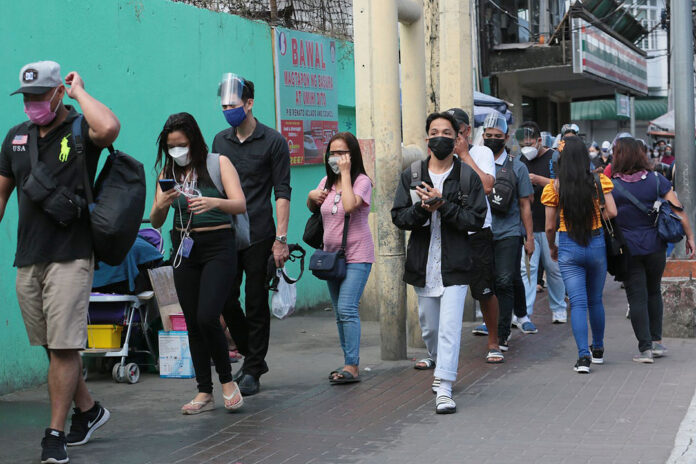By Alyssa Nicole O. Tan
THE PHILIPPINES on Wednesday reported its first two cases of the highly mutated Omicron coronavirus variant, which the World Health Organization (WHO) said was spreading faster globally than any previous strain.
One was a returning migrant Filipino worker from Japan who arrived on Dec. 1 via Philippine Airlines, the Department of Health (DoH) said in a statement. The other was a Nigerian who arrived on Nov. 30 via Oman Air.
Both were currently not showing symptoms, but the Filipino had a cold and cough when he arrived.
The agency said it was tracing people who might have had close contact with the two travelers, who both had been quarantined.
“We assure our people that we will closely monitor developments of the two cases in light of existing protocols, as we continue to remind the public not to let their guard down,” acting presidential spokesman Karlo Alexei B. Nograles said in a separate statement.
He added that people should observe health protocols and get vaccinated as soon as possible to protect them from the coronavirus.
The two samples came from 48 that the Philippine Genome Center had sequenced on Tuesday, DoH said.
The Health department reported 237 coronavirus infections on Wednesday, bringing the total to 2.84 million.
The death toll hit 50,449 after 100 more patients died, while recoveries increased by 565 to 2.78 million, it said in a bulletin.
There were 10,193 active cases, 567 of which did not show symptoms, 3,876 were mild, 3,492 were moderate, 1,867 were severe and 391 were critical.
The agency said 91% of the reported cases occurred from Dec. 2 to 15. The top regions with cases in the past two weeks were Metro Manila with 43 cases, Northern Mindanao with 25 and Western Visayas with 22.
It added that 14% of the reported deaths occurred in December, 32% in November, 36% in October and 6% in September.
DoH said nine duplicates had been removed from the tally, six of which were reclassified as recoveries, while two recoveries were relisted as deaths.
It added that 181 patients had tested negative and were removed from the tally. Four laboratories did not operate on Dec. 13, while three failed to submit data.
The agency said 22% of intensive care units in the Philippines were occupied, while the rate for Metro Manila was 24%.
Meanwhile, the Philippines will remain under Alert Level 2 until the end of the year, the presidential palace said on Wednesday, amid the threat of a highly mutated Omicron variant of the coronavirus.
An inter-agency task force also announced a travel ban on eight territories — Andorra, France, Monaco, Northern Mariana Islands, Reunion, San Marino, South Africa and Switzerland.
Effective Dec. 16 to 31, vaccinated and unvaccinated travelers from these “high-risk” areas that are part of the so-called red list will be banned from entering the Philippines, Mr. Nograles said.
Only Filipinos who are being repatriated from these countries will be allowed entry.
Several countries were also written down under the green list to “release some pressure” on the number of days a person will be under a facility-based quarantine, as spaces are quickly being filled with the increasing number of migrant workers returning for the Christmas holiday, he said.
The Overseas Workers Welfare Administration last week said at least 100,000 migrant Filipino workers have come home for the holiday.
Airline passengers may only board a plane once they test negative three days before departure. Children aged three years and younger are exempted from the requirement.
Passengers from countries classified as safe must be quarantined until RT-PCR results taken on the third day upon arrival come out. Unvaccinated and partially vaccinated travelers will go through the same restrictions except that they should be tested on the seventh day.
For passengers coming from yellow list or moderate risk countries, the protocols are the same except that the test for the vaccinated will be done on the fifth day, while home quarantine will end on the 14th day.
Vaccinated and unvaccinated travelers from red list countries will undergo similar tests on the seventh day, but the latter must stay until the 10th day regardless of the test results. Both must also do home quarantine until the 14th day.
“We humbly request your patience as we and the Inter-Agency Task Force continue to make modifications to our protocols,” Mr. Nograles said. “These are all being done in response to evolving situations around the world.”
“At the end of the day, we want to keep our people safe and we will do what is necessary to achieve that,” he added.

